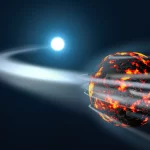Dark matter, the mysterious substance that exerts gravitational pull but emits no light, might really consist of vast concentrations of ancient black holes created at the very start of the universe, according to a new study.
The analysis of the gravitational waves—or ripples in space-time—caused by two far away black hole and neutron star collisions leads to that conclusion.
The Laser Interferometer Gravitational-Wave Observatory (LIGO) in Washington and Louisiana, as well as the Virgo Interferometer near Pisa, Italy, detected the ripples in 2019; they were designated GW190425 and GW190814. According to an earlier analysis, the ripples were likely caused by collisions between black holes that were either much larger or smaller than our sun, or between 1.7 and 2.6 times the mass of our sun.
However, that would result in one of the colliding objects being what astronomers refer to as a solar-mass black hole, with a mass similar to that of the sun.
According to study lead author Volodymyr Takhistov of the University of California, Los Angeles, “solar-mass black holes are quite mysterious, as they are not expected from conventional astrophysics,” such as the star explosions, or supernovas, that crush larger stars into black holes. Takhistov sent an email to Live Science explaining this.
Rather, the study’s authors think that these solar mass black holes might actually be “primordial” black holes formed during the Big Bang. It was published in the journal Physical Review Letters. Alternatively, according to Takhistov, they may have formed later on when neutron stars underwent a transformation into black holes. This could have happened after they consumed primordial black holes or after taking up specific kinds of dark matter, which is a mysterious substance that pulls in gravitational forces but does not interact with light.
Ancient black holes
If primordial black holes exist at all, they were most likely produced in large quantities during the first moments of the Big Bang, approximately 13.77 billion years ago. They would have come in all sizes — the smallest would have been microscopic and the largest tens of thousands of times the mass of our sun.
According to calculations, the smallest primordial black holes would have “evaporated” by now by releasing quantum particles through a process called Hawking radiation; only these with masses larger than 10^11 kilograms, or roughly the mass of a small asteroid, would remain in existence today.
Some astrophysicists speculate that the vast halos of “dark matter” surrounding fringe galaxies may consist of these ancient black holes, if they indeed exist.
The goal of the study was to determine whether primordial black holes could be distinguished from black holes that originated from neutron stars, which are the glowing remains of supernovas that were left over when their parent stars burst due to nuclear fusion reactions depleting all of the hydrogen in the stars.
According to Live Science, astronomers have determined that stars with less mass than five times that of the sun will collapse to form neutron stars, which are composed of extremely dense matter and have about the mass of the sun compressed into a ball the size of a city.
According to this theory, some neutron stars’ strong gravity would have drawn dark matter particles over time. Eventually, the gravitational pull of these particles would have been so great that the neutron star and dark matter would have collapsed into a black hole together, as suggested by the new study.
The study suggests an alternative theory in which a small primordial black hole may have been drawn to a neutron star and merged with it. The black hole would then have settled at the neutron star’s center of gravity and fed off the surrounding matter until it was the only object left.
Gravitational waves
Takhistov and his colleagues reasoned that black holes transmuted from neutron stars would have to follow the same mass distribution of the neutron stars they originated from, which depends on the sizes of their parent stars.
In light of this, the researchers examined the data from the roughly 50 gravitational wave detections that have been made to date and discovered that only two of them, GW190425 and GW190814, involved objects that had the proper masses to be primordial black holes, according to the study’s authors.
The research is insufficient because it is still possible that black holes converted from neutron stars of those sizes or neutron stars of the masses detected were involved in those two collisions. However, the authors noted that this is unlikely given the mass distribution of neutron stars that are thought to exist in the universe.
“Our work advances a powerful test to understand their origin and relation with dark matter,” Takhistov stated. “In particular, this test demonstrates that black holes significantly heavier than about 1.5 solar-masses are very unlikely to be ‘transmuted’ black holes from neutron star disruptions.”
And if that’s the case, the study suggests that primordial black holes may actually exist and may even be a part of dark matter.
Takhistov stated that as more gravitational wave detections are made, the method will become more accurate because “the test is statistical in nature, so gathering more data will allow for a better understanding.”


